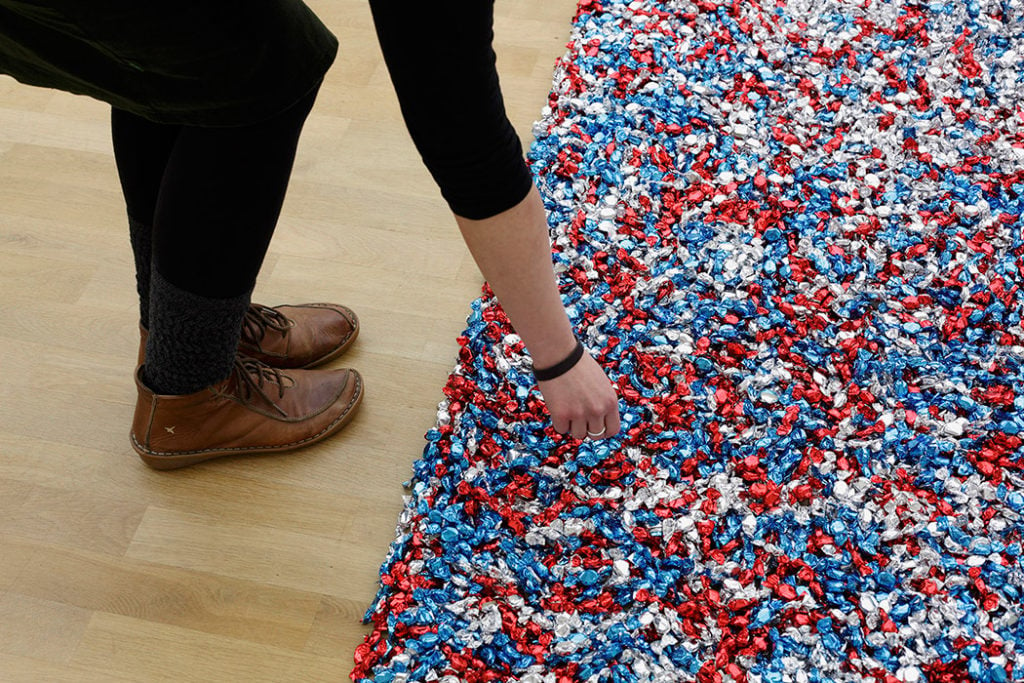Craving snacks during the long months of self-isolation? A never-ending pile of fortune cookies from the late Cuban American artist Félix González-Torres might be coming soon to a location near you.
Most of the world’s art galleries are closed, but David Zwirner and Andrea Rosen are forging ahead with an ambitious and outside-the-box exhibition of González-Torres’s 1990 work . It is the first work in the artist’s “Candy” series—the rest feature wrapped candies—meant invoke both the experience of loss and a sense of immortality.
There’s no telling where you might encounter the mound of Chinese desserts, all free for the taking. Rosen, who is curating the show, has asked 1,000 people around the world to install the work in a location of their choosing—homes, art institutions, and public spaces are all fair game.
This may sound unconventional, but González-Torres’s work isn’t bound by the same restrictions as that of other artists. The owner needs to follow specific but open-ended parameters in manifesting the work, which can be installed in more than one place at a time—making it perfect for our current moment, when much of the world is under indefinite lockdown.
“This is one of the only works in the world that can travel and be accessible right now,” Rosen told Artnet News. “There’s so many people right now trying to do incredible online projects. Felix can actually afford people a physical experience with an artwork—and not just looking at it, but thinking about it, and their involvement and what it means to them.”
There’s also an undeniable poignancy to staging the work right now, given González-Torres’s activism against AIDS, the disease that claimed his life in 1996. But perhaps more importantly, sharing the experience of manifesting the work, normally reserved for the owner and select curators, aims to help combat the sense of loneliness and isolation that so many are feeling at this time.
“What is important about this moment is how global it is,” Rosen added. “It make people acknowledge that significant crises—whether that be a war, a genocide, or the AIDS epidemic—have often been depersonalized for those people who are not affected. This moment is an opportunity to realize what it feels like to be one site, one globe, one world—everything that’s happening affects us all.”

Felix Gonzalez-Torres, (1990). Candies individually wrapped in red, silver, and blue cellophane, endless supply. Installation view of “Felix Gonzalez-Torres: Specific Objects without Specific Form,” Museum Für Moderne Kunst, Frankfurt, Germany, 2011. © The Felix Gonzalez-Torres Foundation, courtesy of Andrea Rosen Gallery, New York.
In 2017, Rosen closed her gallery’s physical space to focus on representing the González-Torres estate—her very first show, back in 1990, featured the artist’s work—teaming up with Zwirner to do so. The new exhibition will open two days after the Félix González-Torres Foundation debuts a new website.
Rosen has invited a diverse group of participants to take part, including friends of González-Torres, artists, curators, colleagues, and even the author of this piece. Each participant has received a detailed set of instructions explaining how to install the work, which is on loan from a private collection. The piles are to feature between 240 and 1,000 fortune cookies. (The original installation was approximately 10,000 cookies.) Each participant is responsible for sourcing their own—you can buy 350 cookies on Amazon for less than $30—and is asked to buy enough to completely replenish the pile once during the duration of the show.
“One of the specific choices,” Rosen explained, “is that halfway through, everyone has to regenerate it to the original size. So everyone has the opportunity to experience both the potential loss within the piece, and also the notions of rebuilding and regeneration that is a very important part of the work.”
Some may find their pile unchanged over the course of the show. For others, perhaps not a single cookie will remain. “There will be very different representations of how it shifts and changes in size and shape every day,” Rosen said. But regardless, at the exhibition’s end, the cookies will cease to be considered a work of art (and some participants will be left with an extremely large supply of fortune cookies to munch on).
Participants are also instructed to document the manifestation of the work in photo and video, from the installation process to interactions with the work over the exhibition’s six-week run.
“The piece is never stagnant. It’s never in the past. It’s always the present,” said Rosen. “It’s alive.”
Source: Exhibition - news.artnet.com



